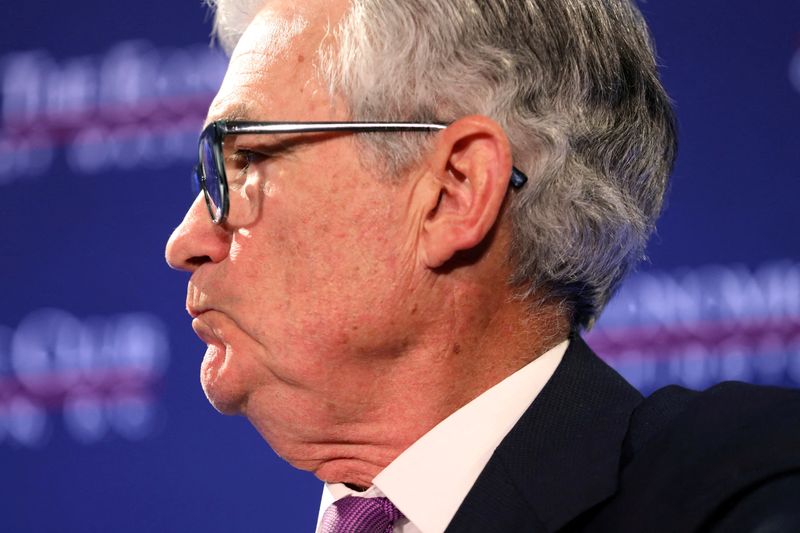By Davide Barbuscia
NEW YORK (Reuters) – Some investors are increasing exposure to longer term U.S. Treasuries in the midst of a historic sell-off, as spiking yields promise to juice returns despite expectations that interest rates will not come down quickly.
Bets that Federal Reserve rate hikes aimed at taming inflation would cause a recession and send Treasuries rallying have ended badly this year, with a resilient U.S. economy bolstering the case for higher rates for longer. As a result, Treasuries are on track for an unprecedented third straight annual loss.
Some of those bets were upended last month when the Fed updated its forecasts, implying another hike this year and projecting high rates will continue through 2024. That pushed long-term yields to 15-year highs as the market finally embraced “no-landing” or “soft-landing” scenarios in which the central bank curbs inflation without causing a recession.
But the latest surge in yields, which rise when bond prices fall, has made long-dated Treasuries more attractive to some investors because they can lock in returns of about 5% on 10 or 30-year U.S. government bonds. By comparison, many believe the returns on shorter-dated debt will likely decline over the same period.
Felipe Villarroel, portfolio manager at TwentyFour Asset Management, said he recently swapped some 10-year Treasuries for higher yielding 30-year Treasuries. At these levels, yields give “a massive cushion in your total returns” to protect against bond prices falling further, he said. Total returns on bonds include interest payments and price changes.
In the week ending Oct. 11, Treasuries saw the largest weekly inflows – $7.2 billion – since March 2023, Bank of America Global Research said in a note. Yields on the benchmark 10-year U.S. Treasury were over 4.95% in Asia trade on Thursday, their highest level in more than 16 years, and 30-year yields breached 5% this month for the first time since 2007.
Matt Smith, investment director at British fund manager Ruffer, has been adding exposure to 30-year Treasuries and 10- and 30-year Treasury inflation-protected securities (TIPS) in recent weeks, roughly doubling the “duration weights” in his portfolio, a measure of a portfolio’s price sensitivity to changes in interest rates.
“The shift of the bond market from hard landing to no landing is what gives us this investment opportunity in price terms,” he said.
Buyers believe the Fed is nearing a peak in its hiking cycle as underlying inflation is cooling, and bonds now have more potential to gain value if the economy slows.
Leslie Falconio, Head of Taxable Fixed Income Strategy at UBS Global Wealth Management, said her exposure to Treasuries was mostly around five-year bonds, but she recently bought seven to ten-year securities to take advantage of higher yields.
“At these levels, we believe you have the tailwind of compounding interest and more than likely price appreciation … because we believe yields will come down in 2024,” she said.
POLICY TRANSMISSION
To be sure, many remain doubtful the bond market will bounce back any time soon. They worry yields still have room to rise due to sticky inflation, as well as widening fiscal deficits and increasing government bond supply, all of which will see investors demand higher compensation for the risk of holding long-term debt.
The Treasury on Wednesday auctioned $13 billion in 20-year bonds which analysts said met good demand after yields rose earlier in the day. An auction of 30-year U.S. Treasuries showed weak demand last week, sending yields higher.
The BlackRock Investment Institute said this week it expected 10-year yields to rise to 5% or higher in the long term, although it became less bearish on long-dated Treasuries for the next 6-to-12 months because bond prices already largely account for higher interest rates.
Still, bond buyers like Ruffer’s Smith are encouraged by recent signs high yields have started to dent risk assets such as stocks and corporate bonds, a sea change from earlier this year when stocks kept climbing despite higher rates.
That shows monetary tightening is starting to ripple through the economy, they said, a view shared by some Fed officials who last week said higher yields were tightening credit to the point of possibly mitigating the need for a further rate hike.
Stocks have bounced back in recent days, but they’re down 4.9% from their July peak. High-yield credit spreads, which indicate the premium investor demand to hold risky corporate debt over safer government bonds, were their widest in over three months as of Oct. 5.
“The tightness that (bond yields) are imposing on the economy and markets is rising … this caps the extra work the Fed needs to do,” said Smith.
(Reporting by Davide Barbuscia; editing by Michelle Price, Ira Iosebashvili and Nick Zieminski)
